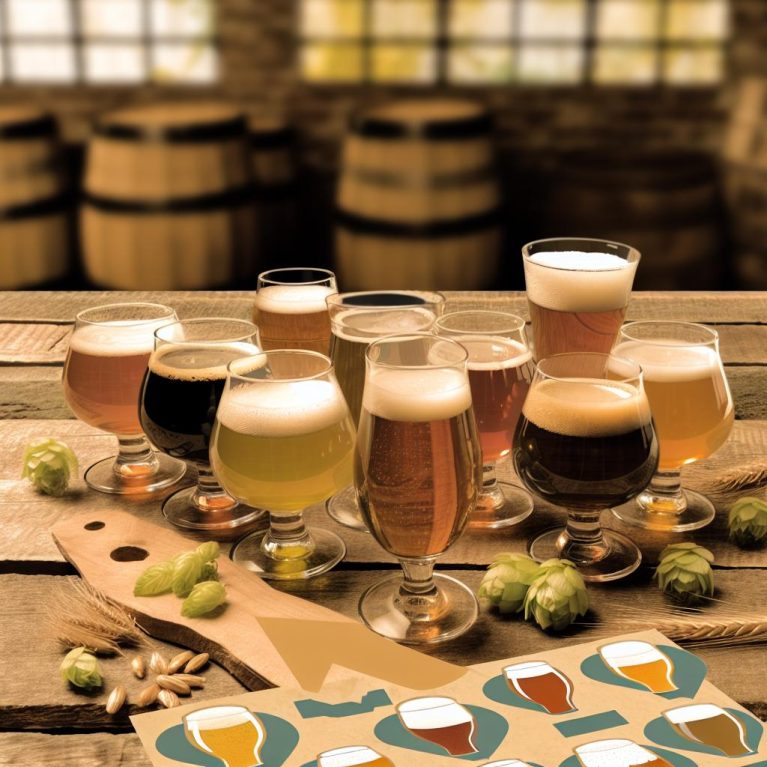The Basics of Craft Beer
Craft beer has gained significant traction and a dedicated following due to its diverse range of flavors and its unique, artisanal brewing methods. For many beginners, however, navigating through the multitude of options can initially seem daunting. With the right foundational knowledge of its core categories and flavor profiles, though, one can make more informed decisions when selecting the ideal beer to suit their taste preferences.
Understanding Beer Styles
Beer is generally categorized into two primary types: ales and lagers. Each of these categories encompasses numerous styles, each with its distinct characteristics and taste experiences.
Ales
Typically, ales possess a robust flavor profile and are produced through a brewing process that occurs at warmer temperatures, allowing for a faster fermentation period. Some of the common types of ales include:
Pale Ales: Renowned for their harmonious balance between hops and malt flavors, pale ales are often considered approachable, especially for beginners. They tend to have a mild degree of bitterness combined with citrusy notes. A classic example within this category is the American Pale Ale (APA).
Stouts: Known for their dark and rich appearance, stouts offer a range of flavors that can vary from hints of coffee to undertones of chocolate. Despite their bold appearance, some stouts boast a remarkably smooth taste, making them an appealing option for individuals who are new to the world of beer.
Lagers
Lagers are generally distinguished by their clean and crisp finish. They undergo a longer fermentation process at lower temperatures compared to ales. Some notable styles of lagers include:
Pilsners: Characterized by a light body and a crisp, clean taste, pilsners often provide a subtle balance between a slight malt sweetness and a delicate hop bitterness. This balance makes them particularly appealing to newcomers who are exploring craft beers.
Helles: Originating from Germany, Helles lagers are known for being slightly maltier and often have a smooth finish accompanied by a touch of sweetness.
Suggested Craft Beers for Beginners
When selecting a craft beer for beginners, it is essential to consider the balance of flavors and the overall accessibility of the beer. Here are some recommended choices that strike a balance between taste and approachability:
Pilsner Urquell
Pilsner Urquell exemplifies the pilsner style beautifully. Its crisp, refreshing taste is accentuated with a hint of bitterness, making it an excellent choice for those who are just beginning to venture into the world of craft beers.
Sierra Nevada Pale Ale
Sierra Nevada Pale Ale provides a delightful blend of hop aroma and malt flavor. This combination creates an accessible yet enjoyable beer experience, especially for novices looking to explore craft beer options.
Guinness Draught
Although stouts can initially appear intimidating, Guinness Draught offers a smooth, creamy texture with subtle flavors reminiscent of coffee and chocolate. This makes it a highly palatable introduction to darker beers.
Exploring Further
For those interested in immersing themselves even more deeply into the world of craft beer, visiting local breweries and taking part in tasting events can introduce a wider array of styles and flavors. Engaging with brewing communities and forums online can also enhance one’s understanding and appreciation of the craft.
The journey into craft beer is a personal exploration, guided by individual preferences. Initially, it is advisable to start with mild or balanced beers before eventually delving into more intense or complex flavor profiles. Over time, this exploration can uncover personal favorites and deepen one’s appreciation for the craftsmanship involved in brewing.
As you navigate through the world of craft beer, here are some additional elements to consider that might further enrich your understanding and enjoyment of beer:
Elements of Flavor
Understanding the primary elements that contribute to a beer’s flavor can offer insight into its characterization:
Malt
Malt is a key ingredient in beer, often contributing sweetness and body. The type of malt used can influence the color and flavor profile of the beer, with different malts offering notes that range from caramel and toffee to biscuit and toast.
Hops
Hops add bitterness, aroma, and flavor to beer. They can introduce a variety of flavors and aromas, including floral, citrus, piney, or earthy notes, depending on the hop variety used. Balancing the hop bitterness with malt sweetness is crucial in achieving a harmonious flavor.
Yeast
Yeast is responsible for fermentation and can significantly impact the taste of the beer. Different strains of yeast contribute distinct flavors and aromas, ranging from fruity and spicy to crisp and clean.
Pairing Beer with Food
Pairing craft beer with food can enhance the dining experience, offering complementary flavors that enrich both the dish and the beer. Consider these general guidelines:
Complementary Pairings
Pair beers with foods that have similar flavor profiles. A light and crisp pilsner, for instance, pairs well with delicate dishes like grilled seafood or a light salad, while a rich stout might be perfectly suited to hearty, robust meals like a chocolate dessert or a well-seasoned steak.
Contrasting Pairings
Some pairings work best by contrasting flavors. A spicy dish might be complemented by a beer with a hint of sweetness or fruitiness to balance the heat, offering an enjoyable flavor contrast.
The Experience of Craft Beer
Drinking craft beer is not just about taste but also about the experience and the story behind each bottle. Many craft brewers pride themselves on their unique brewing traditions and recipes. Learning about a brewery’s history or the inspiration behind a particular beer can enrich the tasting experience.
In conclusion, whether you are just beginning your journey or you have already embarked on your exploration of craft beers, knowledge and experience will guide your preferences. Be open to trying new styles, continue exploring different breweries, and most importantly, enjoy the diverse and rich world of craft beer as you discover the multitude of flavors and aromas it has to offer.

